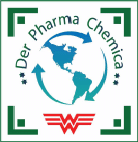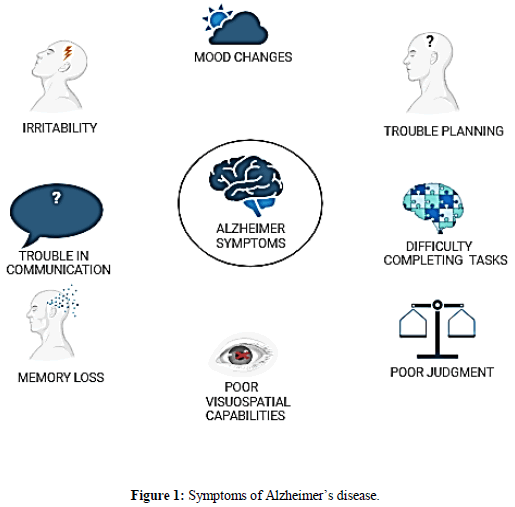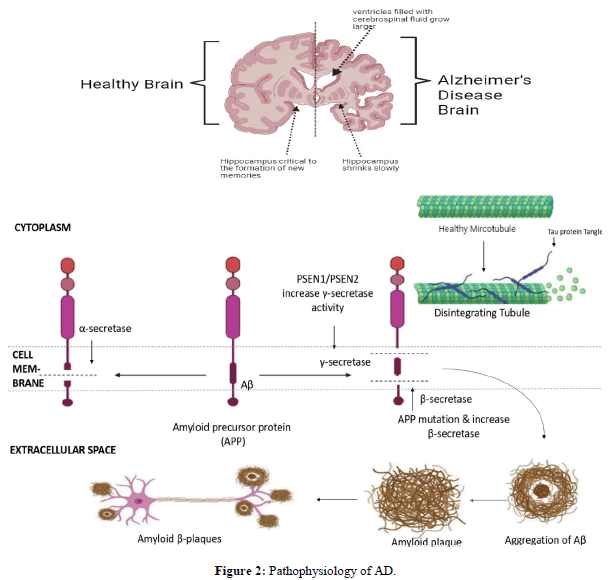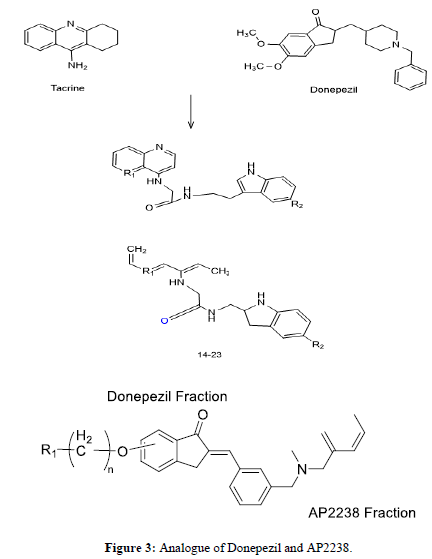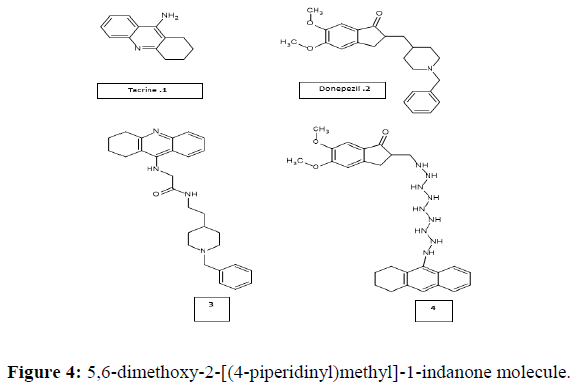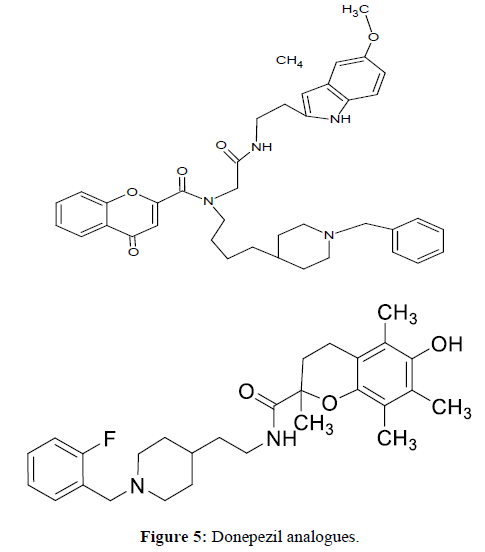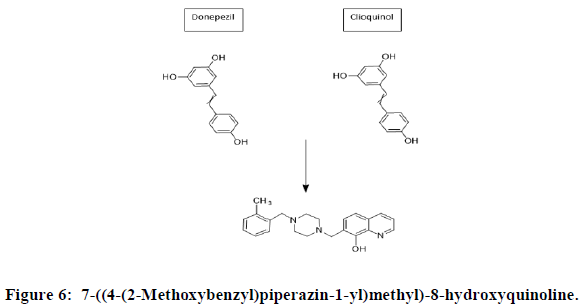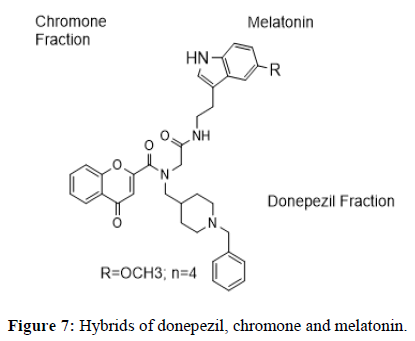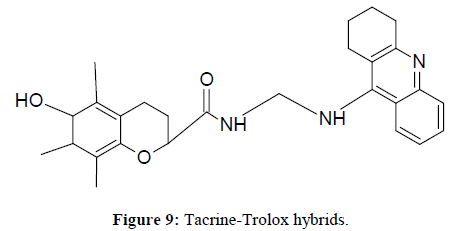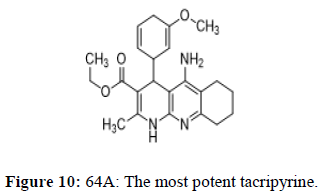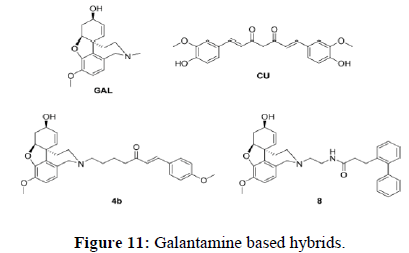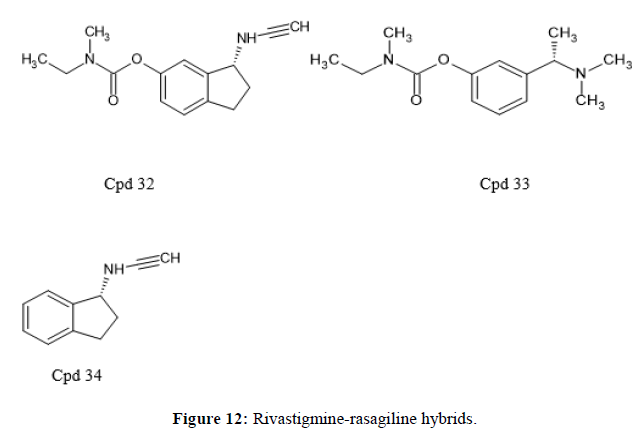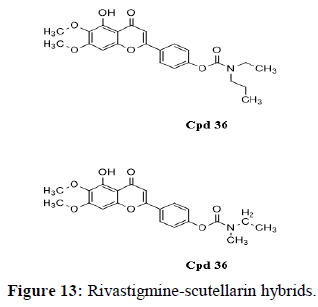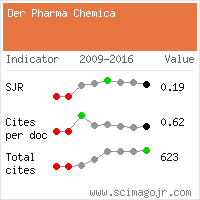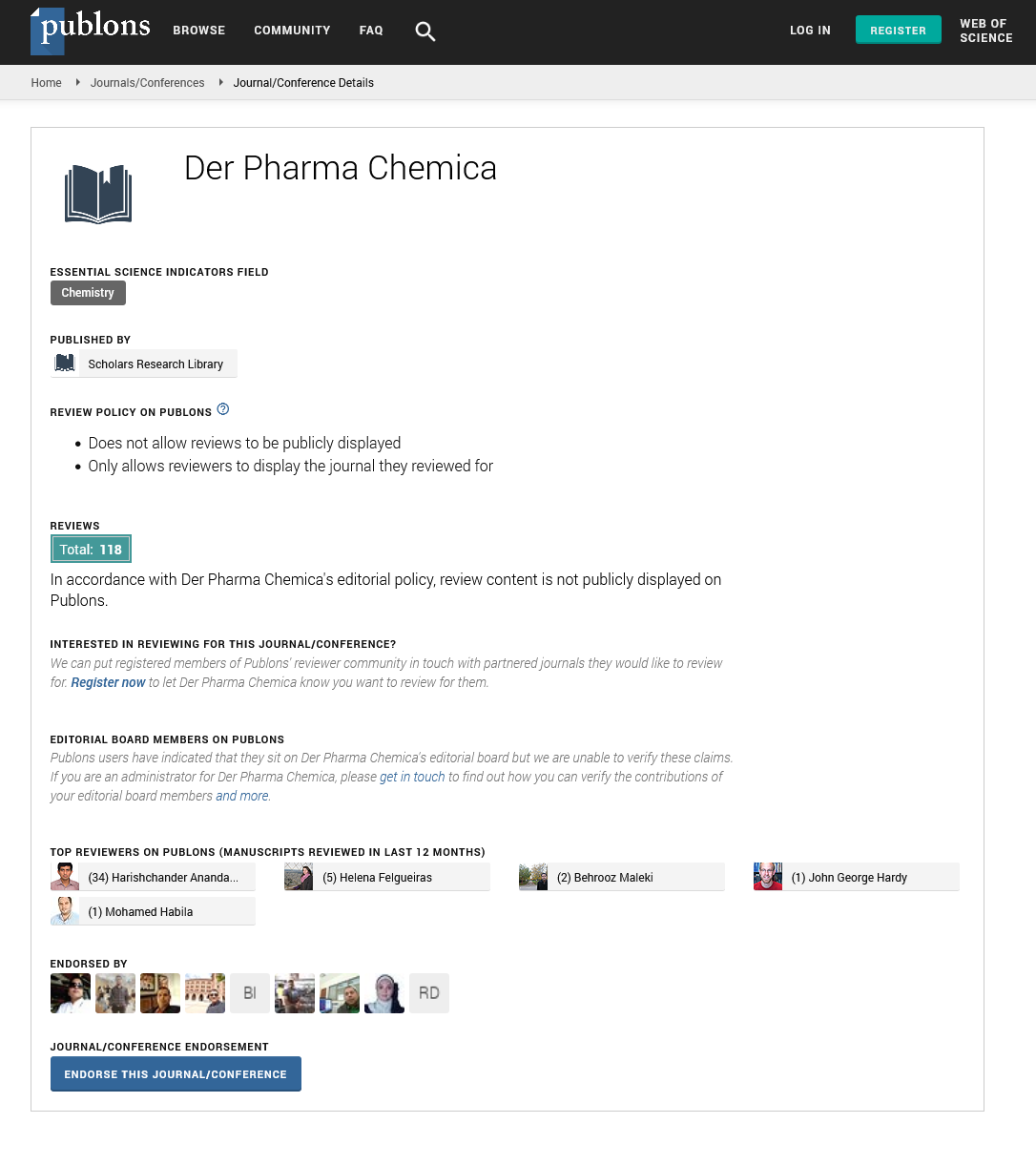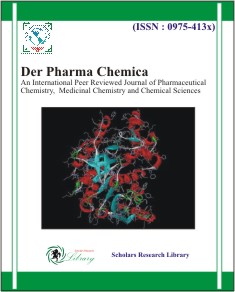Review Article - Der Pharma Chemica ( 2025) Volume 17, Issue 1
Exploring Hybrid Molecules as Multifunctional Treatments for Alzheimer\'s Disease
Nikhil Musale* and Bagade ShashikantNikhil Musale, Department of Pharmaceutical Quality Assurance, SVKMs NMIMS School of Pharmacy and Technology Management, Shirpur, Maharashtra, India, Email: musalenikhil999@gmail.com
Received: 24-Oct-2024, Manuscript No. DPC-24-155478; Editor assigned: 29-Oct-2024, Pre QC No. DPC-24-155478 (PQ); Reviewed: 12-Nov-2024, QC No. DPC-24-155478; Revised: 01-Feb-2025, Manuscript No. DPC-24-155478 (R); Published: 28-Feb-2025, DOI: 10.4172/0975-413X.17.1.562-569
Abstract
Alzheimer's Disease (AD) is one of the most common health conditions in the world and affect neurons and changes several proteins. Based on the 35.6 million of AD cases reported to the world in 2011, the current clinical single molecule treatment of single drug targets single disease component has not been proved to be effective enough and researchers and practitioners are nowadays working together according to the principle of collaboration and focusing on the necessity of collaboration, in order to give a single molecule to multiple disease processes, that is, to nerve cell death. In recent years’ medicinal chemists have been working together to design along with synthesize hybrid molecules. These molecules represent the optimal composition for generating two pharmacologically usable fragments of two oppositely acting chemical species. Alzheimer's Disease (AD), with a continuously increasing global health challenge, is caused by neuronal death and malfunction of various types of proteins. As a global AD population (i.e., approximately 35.6 million AD patients) 2011, collaboration in the medical, scientific and policy spheres is of extreme urgency. The conventional isolated drug "drugs-diseases-drugs" theory of how one drug controls a specific symptom for a single disease has been found inadequate. A multitude of compounds have been screened, such as donepezil-AP2238 hybrids, some donepezil analogues, some tacrine hybrids, galantamine/memantine co-preparation, some rivastigmine hybrids, some physostigmine hybrids and so on.
Keywords
Alzheimer's disease; Hybrid compounds; Neuroprotection; Acetylcholinesterase inhibition; Beta-amyloid aggregation; Neuroinflammation; Oxidative stress
Abbreviation
Aβ-β-Amyloid; Ach: Acetylcholine; AChE: Acetylcholinesterase; AChEIs: Acetylchoinesterase inhibitors; AD: Alzheimer ‘s disease; BChE: Butyrylcholinesterase; APOP: Apolipoprotein; DIAD: Dominantly Inherited Alzheimer's Disease; GAL: Galantamin
Introduction
With millions of cases and mounting pressure on healthcare systems, Alzheimer's Disease (AD) has emerged as a major global health concern. At around 35.6 million people globally, AD has been diagnosed as of 2011, underscoring the urgent need for novel treatment approaches. Traditional treatments have mainly concentrated on single-drug therapies that target specific aspects of the disease, which have proven insufficient due to the complex and multifaceted nature of AD. This challenge has led to a growing interest in the development of hybrid molecules-compounds designed to tackle multiple pathological processes linked to neurodegeneration simultaneously. Recent progress in medicinal chemistry has facilitated the creation of various hybrid compounds that combine established pharmacological agents with new biological activities, aiming to boost neuroprotective effects while inhibiting Acetylcholinesterase (AChE), a key enzyme involved in neurotransmission that is often disrupted in AD [1-3]. This review will explore the progress in the design and evaluation of these hybrid molecules taking considerations for derivatives of known drugs like donepezil and tacrine and hybrids but also donepezil-AP2238, donepezil analogues, combinations of galantamine and memantine, new rivastigmine and physostigmine-based hybrids [4-6].
Literature Review
Epidemiology
Dementia is most frequently caused by Alzheimer's disease, above all other causes. Furthermore, dementia can be caused by a number of cerebrovascular and neurodegenerative diseases, especially in older persons. Only 31 percent of the 184 individuals in one research who satisfied the neuropathological requirements for Alzheimer's disease received a diagnosis. The remaining 17.5% of cases had Alzheimer's disease with α-synuclein and TDP-43 pathology, Lewy bodies from the brainstem and α-synuclein and TDP-43 pathology. Furthermore, each of the pathologically characterized groups had between 29% and 52% of people with multiple infarcts as well. An estimated 6.9 million Americans aged 65 and older are living with Alzheimer's dementia in 2024, with projections indicating this number could rise to 13.8 million by 2060 if no medical breakthroughs occur to prevent or cure the disease [7].
Despite the fact that longer life expectancies have led to a boost in the prevalence of dementia over the past 50 years among both high-income as well as middle and low-income countries. Dementia incidence has slightly reduced in a few wealthy countries, like the USA, UK and France. The decline in the prevalence of dementia might be the result of the shifting of such factors as education, health and environment as the recent generation of youth is coming of age. Educated people are the most fortunate ones who are aware of many necessary for being able to cope with the cackles of cognitive and cerebrovascular illnesses (also known as "cognitive elasticity"). Even though education might be seen as the gateway to a well-functioning life and still be a way of coping it is in the places of fighting the symptoms of neurodegenerative and cerebrovascular diseases (also known as "cognitive resilience").
Wealthier nations have engaged in comprehensive studies regarding the prevalence and occurence of dementia, while nations with low and middle incomes possess significantly less information on this subject. Preliminary research indicates that the prevalence of dementia shows minimal geographical variation, suggesting it is a global affliction (Figure 1).
Pathophysiology
Memory loss and increasing cognitive decline are hallmarks of Alzheimer's Disease (AD), a challenging and complex neurological condition. Environmental factors, genetics and lifestyle choices all have a role in the development of this illness. Amyloid plaques, which are caused by the buildup of beta-amyloid peptides, are a defining feature of Alzheimer's Disease (AD). These plaques are a key characteristic of the disease; they incite inflammation in the brain and disrupt the connections between neurons. Alongside amyloid plaques, another important feature of AD is the overphosphorylation of tau proteins. This process results in the formation of neurofibrillary tangles within neurons, leading to cell death and closely associated with the degree of cognitive decline experienced by individuals. Chronic inflammation in the brain, fueled by activated astrocytes and microglia, worsens synapse loss and neuronal degeneration, speeding up the disease's progression [8-10].
Moreover, oxidative stress significantly impacts the pathophysiology of AD. Reactive Oxygen Species (ROS) buildup damages neurons and promotes neurodegeneration. Cerebrovascular dysfunction also contributes to the illness because ischemic circumstances brought on by reduced blood flow can further compromise the health of neurons. The Figure 2 illustrates these interconnected mechanisms, showcasing how amyloid plaques, neurofibrillary tangles, neuroinflammation, oxidative stress and vascular issues interact within the context of Alzheimer's disease.
Aβ in Alzheimer’s disease: The "p" Numerous studies indicate that Amyloid-Beta (Aβ) may play a role in the development of Alzheimer's Disease (AD). Amyloid Precursor Protein (APP) is broken down into a variety of peptides with varying sizes and physical characteristics by proteases. The average APP is made up of 38-43 amino acids. These peptides, which are referred to as Aβ, are the main constituent of amyloid plaques. Research on the proteolytic digestion of APP has revealed that APP metabolism causes neurons and other cell types to naturally create substantial levels of Aβ throughout an individual's life. Precise function of APP in neuronal contexts remains ambiguous.
The production of Aβ and its conformational change to forms with a high β-sheet structure, however, are the main factors driving the pathophysiology of Alzheimer's disease, according to several studies. APP, PSEN1 and PSEN2 mutations are found in more than 50% of patients with early-onset familial Alzheimer's disease, providing the strongest evidence for Aβ's involvement in the disease.
Tau: background and significance: A key component of neurofibrillary tangles, one of the clinical hallmarks of Alzheimer's Disease (AD), tau protein stabilizes microtubules, which is necessary for preserving neuronal structure and function under normal circumstances. However, tau is hyperphosphorylated in AD, which causes it to aggregate into tangles and paired helical filaments that impair neuronal function and cause neurodegeneration. Studies reveal that tau pathology, frequently more so than Amyloid-Beta (Aβ) plaques, is strongly associated with cognitive deterioration in AD patients. This relationship suggests that tau may serve not only as a biomarker for diagnosing AD but also as a potential therapeutic target. Understanding the mechanisms behind tau's role in AD is crucial for developing effective treatments aimed at mitigating its neurotoxic effects and improving patient outcomes.
Discussion
Traditional and current treatments in AD
Traditional treatments: Historically, traditional treatments have included cholinesterase inhibitors (such as donepezil, rivastigmine and galantamine) and the NMDA receptor antagonist memantine. These pharmacological agents primarily aim to alleviate symptoms by enhancing cholinergic transmission and modulating glutamatergic activity, respectively. However, they do not modify the underlying disease progression or prevent neuronal death. Additionally, Traditional Oriental Medicines (TOMs), which include various herbal formulations from East Asia, have been utilized for centuries to manage dementia symptoms. Recent studies have indicated that compounds derived from TOMs exhibit potential therapeutic effects on cognitive functions and may address pathological features of AD, such as amyloid-beta accumulation and tau hyperphosphorylation.
Current treatments
In recent years, the focus has shifted towards disease-modifying therapies. Monoclonal antibodies like lecanemab and donanemab have received FDA approval for early-stage AD. They target amyloid-beta plaques, aiming to slow cognitive decline by preventing plaque formation and promoting clearance. These treatments represent a significant advancement in AD management, moving beyond mere symptomatic relief. Research is also exploring hybrid therapies that combine multiple pharmacological agents targeting different pathways involved in AD pathology. This approach mirrors strategies used in cancer treatment and aims to enhance therapeutic efficacy by addressing the multifactorial nature of AD.
Hybrid molecules for the management of Alzheimer's disease
A promising approach to treating the complicated pathophysiology of Alzheimer's Disease (AD) is the use of hybrid molecules. Traditional treatments often focus on single-target mechanisms, which have shown limited effectiveness in altering disease progression. In contrast, hybrid compounds integrate multiple pharmacophores-bioactive components-into a single molecule, enabling a broader therapeutic approach.
Mechanisms and benefits of hybrid molecules: Hybrid molecules' architecture enables them to target multiple pathways linked to AD at once, such as tau hyperphosphorylation, oxidative stress, neuroinflammation and amyloid-beta buildup. Recent studies suggest that these compounds can enhance treatment efficacy while reducing the side effects associated with using multiple medications. For instance, several compounds of cinnamic acid have been found to have the capacity to modify tau pathology and prevent amyloid aggregation. These studies indicate that hybrid molecules not only possess improved pharmacological profiles but also exhibit lower toxicity compared to traditional single-target therapies. The ability of these compounds to act on multiple targets enhances their appeal as candidates for future drug development. Even with encouraging findings, more study is required to address issues like off-target impacts and long-term safety concerns. Continued exploration of hybrid therapeutics may lead to innovative treatments capable of effectively modifying the course of Alzheimer's disease.
Donepezil
Donepezil and AP2238: The first substance to be discovered having two binding sites that allowed it to interact with both of the Acetylcholinesterase's (AChE) anionic sites was AP2238. The methods of action of donepezil and AP2238 against AChE are similar; however, AP2238 has a greater ability to prevent toxicity caused by Amyloid-Beta (Aβ). It has led to the creation and evaluation of several donepezil-AP2238 hybrids. Figure 3 shows the structure of the hybrid donepezil-AP2238. Notably, these compounds feature a five-carbon alkyl chain terminating in an amino group, which significantly enhances their interaction with the Peripheral Anionic Site (PAS) of AChE.
Donepezil-tacrine hybrids: In order to target the active site, mid-gorge binding site and peripheral site of Acetylcholinesterase (AChE), Camps, et al., have created a number of novel donepezil-tacrine hybrids. This comprehensive strategy is especially remarkable because tacrine and donepezil are both well-known medications that have a history of breaching the Blood-Brain Barrier (BBB). By improving the inhibition of AChE and addressing the aggregation of Beta-Amyloid (Aβ), a significant pathogenic hallmark of AD, the synthesis of these hybrids seeks to increase the therapeutic efficacy against AD. The ability of the newly produced hybrids to prevent Aβ aggregation caused by both AChE and Butyrylcholinesterase (BuChE) was assessed. Together with 6-chlorotacrine, the structural design included the 5,6-dimethoxy-2-[(4-piperidinyl)methyl]-1-indanone molecule from donepezil. AChE binding affinity and selectivity were improved by structural alterations. Surprisingly, these hybrids showed far better inhibition of human AChE than their parent drugs, with some displaying subnanomolar IC50 values. These hybrids demonstrated strong cholinesterase inhibition as well as significant anti-aggregating activity against Aβ, confirming their promise as multipurpose treatments for AD. A five-carbon alkyl chain ending in an amino group was discovered to improve binding affinity and biological activity by enabling stronger interactions with AChE's Peripheral Anionic Site (PAS). In the overall quest for better treatments for Alzheimer's disease, the creation of donepezil-tacrine hybrids marks a substantial breakthrough. These chemicals have the potential to improve patient outcomes and perhaps change the course of AD by concurrently addressing various processes involved in the disease's pathogenesis (Figures 4 and 5).
Improvements in cognitive function and spatial memory were observed in a study that treated chronic oxidative stress brought on by D-galactose (D-gal) and AlCl3 in a mouse model, as well as scopolamine-induced acute memory impairment, while attempting to prevent acute toxicity and hepatotoxicity. Antioxidant qualities, the capacity to sequester Cu2+ ions and the ability to protect PC12 cells from oxidative stress caused by rotenone, oligomycin-A and H2O2 were all shown during the investigation. Additionally, it was shown in vitro that BV-2 cells had a great potential to cross the blood-brain barrier and can reduce inflammation brought on by LPS. Lozinska and colleagues created particular BChE inhibitors prepared a new series of hybrids from donepezil-melatonin. For coupling with the aim of obtaining N-benzylpiperidine derivatives substituted with alkylamines, an equivalent carbonate to N-acetylserotonin was used. An additional carbamate bond that is linked to melatonin's aromatic system was added to the linker between the two major moieties in order to improve the interaction with BChE. Analogous to what was seen with tacrine and melatonin derivatives, this alteration led to an increased affinity towards BChE.
Additionally, a unique set of hybrids between hydrozinonicotinamide and donepezil were created and put through a bio assessment. All of the compounds that were developed had superior selectivity and affinity for AChE relative to BChE. Additionally, they demonstrated greater activity against BChE and AChE than the reference drug donepezil. Hybrids of donepezil, melatonin and chromone are the next fascinating class of donepezil compounds to be investigated as potential multipurpose therapies for AD. Of the compounds in the series, number 16 showed the most promise. Its IC50 values were 11.90 ± 0.05 nM, indicating significant inhibition of hBChE. The IC50 values for hAChE, hMAO-A and Monoamine Oxidase B (MAO-B) were 1.73 ± 0.34 μM, 2.78 ± 0.12 μM and 21.29 ± 3.85 μM, respectively, indicating a moderate inhibition of these genes. Additionally, this derivative's strong antioxidant properties (3.04 TE) were discovered. The IC50 values for hAChE, hMAO-A and Monoamine Oxidase B (MA-OB) were 1.73 ± 0.34 μM, 2.78 ± 0.12 μM and 21.29 ± 3.85 μM, respectively, indicating a moderate inhibition of these genes.The significant antioxidant capabilities (3.04 TE) of this derivative were also found. It should be noted that patients with moderate to severe forms of AD benefit greatly from this specific BChE inhibitor. In order to treat AD, donepezil-trolox hybrids were created, incorporated and bioevaluated as multifunctional drugs. For the most dynamic molecule in series 18, MAO-B, they demonstrated moderate to high restraint, with an IC50 upwards of 4.3 μM and hAChE of 0.54 μM. It also displayed remarkable cell reinforcement and Aβ1–42 inhibitory movement. unprecedented disease avoidance specialist influence (IC50=41.33 μM by DPPH methodology, 1.72 and 1.79 TE by ABTS and ORAC methodologies) and ability to chelat Cu2+ particles. It didn't show immense toxicity in HepG2, PC12, in addition, to BV-2 cells (murine microglia cell line), too in light of everything prepared to protect cells from oxidative strain achieved by H2O2, rotenone and oligomycin-A. Also ,oral administration of this straightforward better insight and spatial memory in anticipation of scopolamine-started serious memory lack, D-galactose (D-woman) and AlCl3 prompted determined oxidative strain in mice models without extreme harmfulness and hepatotoxicity. This subordinate revealed the ability to cross BBB in vitro.
Hybrids of donepezil and clioquinol: According to logic, combining the 8-hydroxyquinoline component with benzylpiperidines (as a donepezil pharmacophore) produced a unique class of hybrid compounds that scavenged free radicals, inhibited ChE, chelated Zn(II) and Cu(II) and inhibited Aβ aggregation. The aromatic and planar 8-hydroxyquinoline substituted for donepezil's indanone core preserves its affinity for the peripheral region of AChE without changing its molecular weight. Nonetheless, the majority of the recently created hybrids were able to specifically target human Butyrylcholinesterase (BuChE) and efficiently reduce Aβ self-aggregation. Alternatively, the 7-((4-(2-methoxybenzyl)piperazin-1-yl)methyl)-8-hydroxyquinoline showed good in vitro antioxidant activities, mild toxicity and well-balanced anti-aggregating and AChE properties in parallel artificial membrane permeability studies (Figure 6).
Hybrids of donepezil,chromone and melatonin: The fundamental component of many flavonoid derivatives is chromone. However, by preventing the synthesis of Aβ and tau hyperphosphorylation, the neurohormone melatonin has neuroprotective benefits against AD. L-Monoamine Oxidases (MAOs) can catalyze the oxidation of monoamines. Pamchon-Angona et al. created a hybrid donepezil-chromone-melatonin as a multi-target medication.149 Compound 18, a promising multitarget small molecule, was reported to have significant antioxidant power, moderate hAChE (IC50=1.73 μM), strong BuChE inhibition (IC50=11.90 nM), moderate hMAO-A and MAO-B (IC50=2.78 μM and 21.29 μM, respectively) and moderate hMAO-B inhibition (Figure 7).
Tacrine hybrids
Tacrine hybrids having antioxidant activity.
Tacrine-melatonin hybrids: Melatonin, a powerful antioxidant and tacrine, a cholinesterase inhibitor, have been combined to produce multipurpose molecules that are intended to treat Alzheimer's disease. These hybrids incorporate melatonin's neuroprotective and free radical scavenging properties with tacrine's cholinesterase inhibition. Research indicates that these hybrids offer strong antioxidant protection, lessen amyloid-beta aggregation and inhibit Acetylcholinesterase (AChE). Significantly, tacrine-melatonin hybrids reduce amyloid plaque development and neuronal cell death in animal models of AD, improving cognitive performance. These pharmacophores work together to offer a promising multitarget-directed treatment strategy for neurodegenerative illnesses (Figure 8).
Tacrine-Trolox hybrids: Recently, new multifunctional tacrine-trolox hybrids with hepatoprotective qualities have been created and synthesized to combat AD. Similar to trolox alone, the majority of hybrids exhibited excellent antioxidant activity while inhibiting AChE in the nanomolar range. It was discovered that Cpd 25 was a strong AChEI (IC50=23.5 nM) and BuChEI (IC50=20.5 nM) and less hepatotoxic than tacrine. It also showed a significant degree of BBB bridging ability and a neuroprotective effect against PC 12 cells damaged by H2O2 (Figure 9).
Tacrine Di-hydropyridine hybrids: 4-Dihydropyridine is a specific blocker of voltage-dependent calcium channels, inhibiting their activity. When too much calcium (Ca2+) builds up in cells, it negatively affects mitochondrial function. Recent research indicates that this calcium overload contributes to the progression of AD. This excessive calcium triggers various pathological processes, including hyperphosphorylation, aggregation of beta-amyloid proteins and activation of apoptotic signaling pathways, ultimately culminating in cellular death. Tacrine-dihydroxypyridine hybrids have been described in the literature. for their anticholinesterase properties, neuroprotective effects and function as mild calcium channel blockers. Particularly, Compound 64A featuring X as 3-OMe demonstrated the highest inhibitory potency against h-AChE with an IC50 value of 58 nM (SI of 1724) (Figure 10).
Galantamine based hybrids: Galantamine (GAL) is a well-known treatment for Alzheimer's Disease (AD). It works mainly as an inhibitor of Acetylcholinesterase (AChE), which raises the levels of acetylcholine, a neurotransmitter crucial for memory and learning. This increase in acetylcholine availability helps patients with AD avoid cognitive decline. GAL also acts as an allosteric modulator of α7 Nicotinic Acetylcholine Receptors (nAChRs), which improves cholinergic signaling and has neuroprotective effects against the toxicity of Amyloid-Beta (Aβ), peptides. This dual mechanism not only aids in restoring synaptic function but also plays a critical role in preventing apoptosis triggered by Aβ aggregation, a key pathological feature of AD. They have gained attention through hybrid compounds that use the synergetic mechanism of galantamine and curcumin have been proposed. Curcumin, a natural polyphenol which is derived from turmeric, is known to possess antioxidant and anti-inflammatory effects, which is useful in preventing neurodegenerative diseases. In the lab experimental studies, these hybrids afford significant protection against Aβ toxicity to neuronal cell lines, such as SH-SY5Y cells, by inhibiting Aβ aggregation, enhancing mitophagy and AMPK activation that helps to eliminate toxic protein aggregates. So in conclusion, the combination of galantamine and curcumin in hybridization leads to a new strategy that could produce the best therapeutics that are required in Alzheimer's disease (Figure 11).
Rivastigmine based hybrids
Rivastigmine-rasagiline hybrids: Weinstock and colleagues created the Cpd_collections derivatives TV3326 (Cpd 32) by linking the phenyl N-ethyl-N-methylcarbamate moiety for rivastigmine (Cpd 33) with the previously mentioned selective irreversible MAO-B inhibitory compound, an anti-Parkinson agent 1-propargyl-(1R)-aminoindane scaffold. The dual inhibitory properties of Cpd 32 for monoamine oxidase (MAO-A and MA-OB) and its favorable safety profile complement its proven AChE inhibitory effectiveness. Along with helping with cognition and reducing oxidative stress, it also has antidepressant properties. Moreover, Cpd 32 stimulated an increase in sAPPα levels on human SH-SY5Y and rat PC-12 neuroblastoma cells by altering the α-secretase APP processing pathways (Figure 12).
Rivastigmine-fluoxetin hybrids: Despite the fact that SERT inhibitors have no known anticholinergic effects, they are used to treat Alzheimer's disease-related depression. A new family of dual inhibitors that target the acetylcholinesterase and serotonin transporter was developed by Kogen, et al., in light of these variables, potentially providing a unique treatment option for AD associated with depression. One of the recently created hybrids, compound 35, was created by using the structures of the powerful SERT inhibitor fluoxetine and the AChE inhibitor rivastigmine (Cpd 33) as templates. It showed better AChE inhibitory activity (IC50=101 nM) than rivastigmine (IC50=11 μM, AChE derived from mouse brain) and functioned similarly to fluoxetine as an inhibitor of serotonin transporters.
Rivastigmine-scutellarin hybrids: In a recent study, Sang, et al. used a multi-target-directed ligand strategy to create a series of rivastigmine-scutellarin hybrids. Among these hybrids, compound 36 (Cpd 36) showed dual inhibitory action against Butyrylcholinesterase (BuChE) and Acetylcholinesterase (AChE), with corresponding IC50 values of 22.6 μM and 0.57 μM. Additionally, Cpd 36 exhibited antioxidant properties equivalent to 1.3 times that of trolox. Indeed, these hybrids demonstrated strong neuroprotective effects against scopolamine-induced cognitive impairment in rats by crossing the in vitro blood-brain barrier. Also referred to as 4,5,6-trihydroxyflavone-7-glucuronide, scutellarin exhibits a number of pharmacological traits associated with neurological disorders. Among other things, they can scavenge free radicals, show neuroprotective actions, reduce inflammation and stop the formation of Aβ fibrils. They have the ability to chelate metals as well. Nevertheless, scutellarin's therapeutic potential as an anti-alzheimer's disease drug is limited by its inadequate blood-brain barrier penetration and low oral absorption by conjugating Scutellarin with rivastigmine, this constraint was overcome. Upon analyzing its kinetics, Cpd 36 was found to interact with the catalytic and peripheral anionic sites of acetylcholinesterase, displaying a mixed-type inhibition pattern (Figure 13).
Physostigmine based hybrids
Physostigmine-selegiline hybrids
Recanatini et al. designed the first physostigmine analogs with the goal of enhancing pharmacological properties and introducing dual binding site characteristics. These analogs were designed to improve upon the original physostigmine molecule, which has an IC50 value of 14 nM. They achieved this by attaching an N-Methyl-N-(3-carbamoyloxyphenyl) methylamino side-chain to the tertiary amino nitrogen of physostigmine via a variable-length alkoxy linker. In compared to physostigmine, the heterodimer hybrid xanthostigmine (cpd44) is 46 times more potent and has good inhibitory efficacy against human AChE. It also binds more strongly and with more affinity in the PAS site of AChE. When Fink, et al., coupled a unit of the heteroaromatic N-methylcarbamate of physostigmine with the propargylamine part of the irreversible MAO inhibitor selegiline (Cpd 47), they created a hybrid (Cpd 46) that was found to be more active than the parent substances.
Conclusion
In conclusion, the exploration of hybrid molecules presents a promising avenue for the management of Alzheimer's Disease (AD). By addressing the complex pathology of AD through multifunctional approaches, hybrid compounds offer the potential for enhanced neuroprotection, reduced amyloid-beta aggregation and inhibition of acetylcholinesterase activity. The synthesis and evaluation of various hybrids such as donepezil-tacrine, galantamine-based hybrids and others demonstrate the capacity to tackle multiple targets, offering improved therapeutic efficacy over traditional treatments. Although challenges such as off-target effects and long-term safety remain, the potential for these compounds to modify the course of AD is significant. Continued research into hybrid molecules could lead to more effective treatments, improving patient outcomes and offering hope for better management of this debilitating disease.
Acknowledgements
We would like to express our sincere gratitude to SVKM's NMIMS, School of Pharmacy and Technology Management, Shirpur Campus for providing the necessary infrastructure and resources to carry out this research. Special thanks to Dr. Shashikant B. Bagade for his invaluable guidance and support throughout the project. We also appreciate the contributions of our colleagues who assisted in various stages of this work. Finally, we are grateful for the inspiration and knowledge gained from numerous research studies that formed the foundation of this review.
References
- Karanth S, Nelson PT, Katsumata Y, et al. JAMA Neurol. 2020; 77(10): p. 1299-1307.
[Crossref] [Google Scholar] [PubMed]
- Brodaty H, Breteler MM, DeKosky ST, et al. J Am Geriatr Soc. 2011; 59(5): p. 923-927.
[Crossref] [Google Scholar] [PubMed]
- Wu YT, Beiser AS, Breteler MM, et al. Nat Rev Neurol. 2017; 13(6): p. 327-39.
[Crossref] [Google Scholar] [PubMed]
- Stern Y. Lancet Neurol. 2012; 11(11): p. 1006-1012.
[Crossref] [Google Scholar] [PubMed]
- Prince M, Ali GC, Guerchet M, et al. Alzheimer's Res Ther. 2016; 8(1): p. 23.
[Crossref] [Google Scholar] [PubMed]
- Selkoe DJ, Hardy J. EMBO Mol Med. 2016; 8(6): p. 595-608.
[Crossref] [Google Scholar] [PubMed]
- Hyman BT, Phelps CH, Beach TG, et al. Alzheimer's Dementia. 2012; 8(1): p. 1-3.
[Crossref] [Google Scholar] [PubMed]
- Zlokovic BV. Nature Rev Neurosci. 2011; 12(12): p. 723-738.
[Crossref] [Google Scholar] [PubMed]
- Viayna E, Sola I, Bartolini M, et al. J Med Chem. 2014; 57(6): p. 2549-2567.
[Crossref] [Google Scholar] [PubMed]
- Huang L, Su T, Shan W, et al. Bioorg Med Chem. 2012; 20(9): p. 3038-3048.
[Crossref] [Google Scholar] [PubMed]
